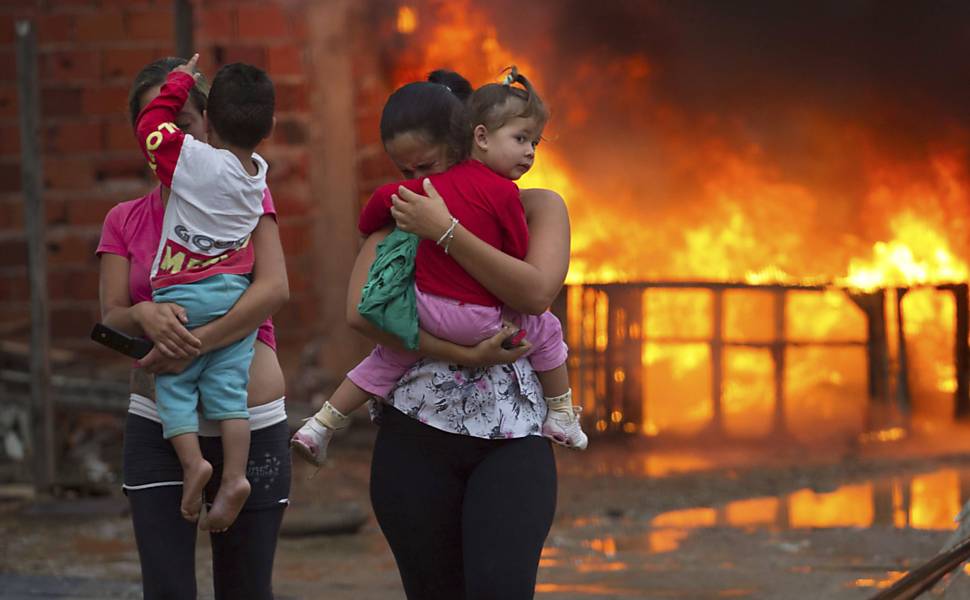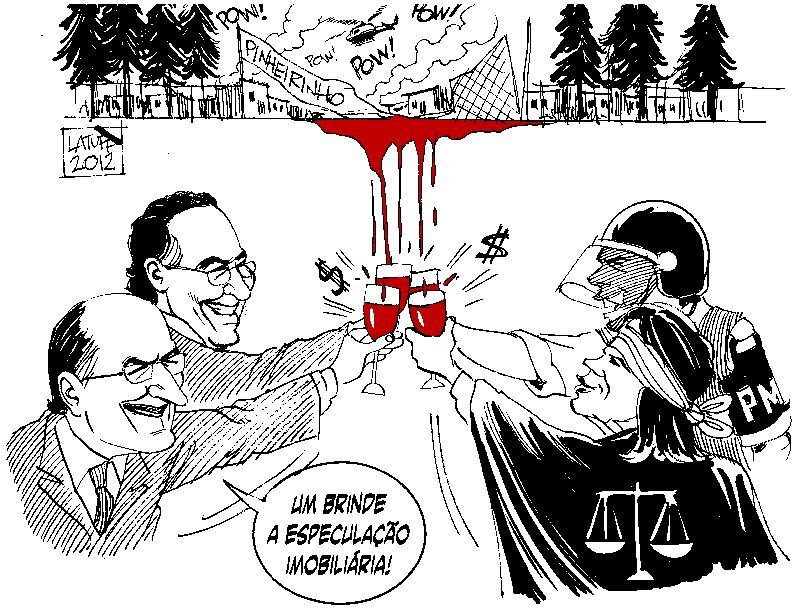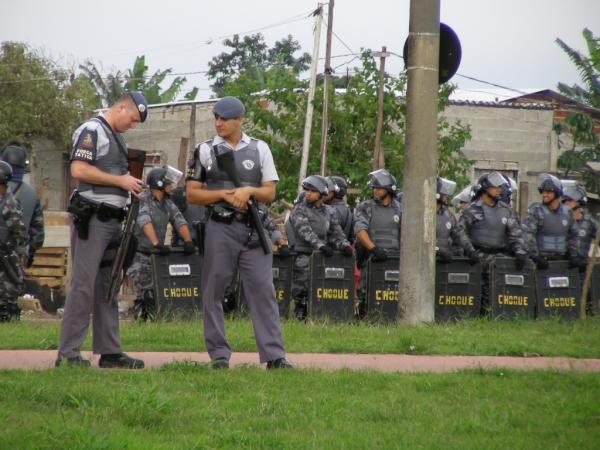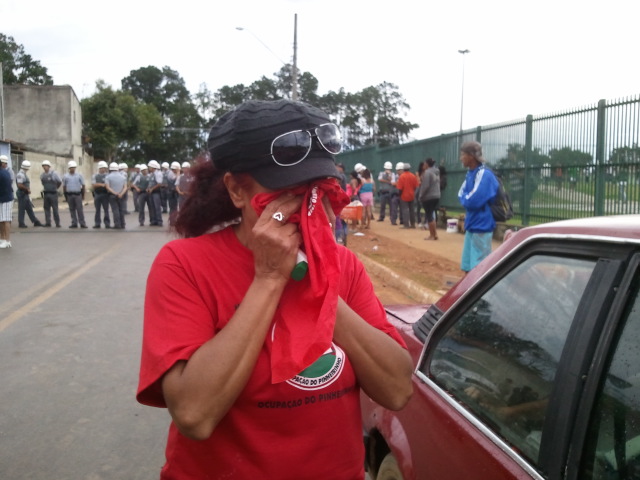[All the links lead to Portuguese language pages.]
On January 22, the Military Police of São Paulo (PMSP) and the Metropolitan Civil Guard (GCM) of the city of São José dos Campos, in the state of São Paulo, invaded the settlement known as Pinheirinho to comply with an order of repossession issued by the state court. The violent eviction of the community became known as “Massacre do Pinheirinho” (Massacre of Pinherinho) after a demonstration of violence and brutality by the police in the expulsion and intimidation of residents dumped in the midst of a huge legal mess.

Women with children in the lap leave their homes with the fire of the barricades behind. Photo of RDTEIXEIRA for the blog Vírus Planetário, under CC license.
The land of the Pinheirinho, occupied for eight years and where more than 1,500 families live (something between 6,000 and 9,000 people), belongs to the bankrupt estate of the Lebanese-born speculator Naji Nahas and his company, Selecta. Nahas, who has been arrested in the past by federal police for financial crimes, became the owner of the land in the early 80's although there is no information about how the acquisition was made after the unsolved murder of the former owners in 1969.
The government of Sao Paulo had demanded the return of the property in mid-January and several comings and goings in court turned the case into a big mess, with the federal government willing to buy and regularize the land, but with the municipality of São José dos Campos and the government of São Paulo refusing to comply with the agreement.
But the order for the repossession of the land was suspended when the state and federal governments agreed to open a window of negotiation of 15 days for the local government to decide whether to proceed or to turn the one million square meters area into “social interest land”, then passing ownership to the residents, mostly poor workers and their families.
The agreement, however, was unilaterally breached and without warning the Military Police arrived at the scene with a force of close to 2,000 heavily armed men, and an unknown number of Civil Guards, in order to evict the land. As expected, there was resistance.
Even though taken by surprise, residents tried to set up barricades, setting fire to cars, public buildings and by throwing stones, showing total despair in face of the violent action of the police.
The city hall of São José dos Campos, that in some cases has paid tickets for some residents to return to their hometowns, especially in northeastern Brazil, has housed the families driven from their homes in precarious shelters. The residents were registered and given blue bracelets to allow their entry into the shelter.
The activist Paloma Amorim, on Facebook, denounced the precariousness of the structure available to serve the homeless families:
As tendas armadas pela prefeitura e pelo governo, portanto, foram armadilhas para aglomerar e agredir famílias indefesas que estão há 7 anos ocupando o Pinheirinho, massa falida que só está neste momento sendo reivindicada em função da especulação imobiliária tão contundente nos últimos tempos no estado de São Paulo.
Video that shows the moment in when, at the end of the day, the Military Police advances on the population with extreme violence:
Judicial matter
Existia uma negociação avançada para resolver o problema sem o uso da força. Por conta disso, por duas vezes, o Tribunal Regional Federal (TRF) cassou a liminar que determinava a reintegração de posse: na sexta feira e no próprio dia da invasão, domingo.
Later, the president of the Supreme Court of Justice (STJ), Ari Pargendler decided that the São Paulo state order would prevail against the federal one, despite the declaration made by the national President of the Bar Association of Brazil (OAB), Ophir Cavalcante, denouncing the eviction as illegal. At stake was the defense of private property of a known speculator versus the right to housing for the poor in the country and the social function of the land.
The Supreme Federal Court, the highest court in Brazil, was driven to try to resolve the issue.
Blogger Fabrício Cunha comments:
Quando esse tipo de interpretação do conceito de propriedade privada sobrepõe a dignidade humana, há algo de muito errado em nossa sociedade.
Quando uma prefeitura finge que não vê um número tão grande de pessoas e não as considera em sua gestão, há algo de muito errado com a política.
Quando um prefeito lava as mãos em silêncio diante de um fato que acontece debaixo de seus olhos, há algo de muito errado com um líder.
When this kind of interpretation of the concept of private property overrides human dignity, there is something very wrong in our society.
When a city government pretends not to notice such a large number of people and does not consider them in their administration, there is something very wrong with politics.
When a mayor washes hands in silence before an event that happens under his eyes, there is something very wrong with a leader.
Urbanist and UN Special Rapporteur Raquel Rolnik explains:
Milhares de homens, mulheres, crianças e idosos moradores da ocupação Pinheirinho são surpreendidos por um cerco formado por helicópteros, carros blindados e mais de 1.800 homens armados da Polícia Militar. Além de terem sido interditadas as saídas da ocupação, foram cortados água, luz e telefone, e a ordem era que famílias se recolhessem para dar início ao processo de retirada. Determinados a resistir — já que a reintegração de posse havia sido suspensa na sexta feira – os moradores não aceitaram o comando, dando início a uma situação dramaticamente violenta que se prolongou durante todo o dia e que teve como resultado famílias desabrigadas, pessoas feridas, detenções e rumores, inclusive, sobre a existência de mortos.
Criticism towards the reasons for the hurried repossession and the extreme violence against the population can be explained by the immense appreciation of the value of the land in the last eight years and the proximity between landowner Nahas and powerful political leaders.
Video of activist Mariana Parra shows the beginning of the severe beating and arrest of the MTST militant (Movement of Homeless Workers) William Boulos who was taken, bloodied, to the police station by Municipal Guards and the despair of the population in face of the violence:
In this link you can watch the violence against the MTST militant from another angle and even the moment where he, bloodied, was taken to a police car. The famous Portuguese academic Boaventura Sousa Santos declared his support for the population of Pinheirinho in a video, rejecting the violent action of the State.
There is no official confirmation of the number of dead or wounded. On one hand, the Military Police and the Department of Communication of the City of Sã0 José dos Campos reports that there are few injuries and there were no fatalities, but various images suggest that at least the number of wounded is high. The Agência de Notícias das Favelas [Slum News Agency] noted the number of dead as seven, while the city's OAB [Bar association] talks about several deaths, including a child, and residents came to point to something between three and four fatalities throughout the day of January 22.
The Metalworkers Union of São José dos Campos compiled images of the beginning of the expropriation of the land:
According to the activist Pedro Rios Leão there are reports that the police and the city civil guard were kidnapping wounded and dead residents in order to prevent them from being counted in official statistics. Captain Antero of the Military Police had stated that there was no record of deaths nor serious injuries in the early evening of the 22nd, but the facts have begun to contradict him, such as the report by the Solidarity on the Pinheirinho Occupation Blog that a resident may be paralyzed after being hit by a police bullet.
The Military Police claimed not to use firearms, only rubber bullets, but the images in both photo and video show that the GCM carried pistols with live ammunition.

“A toast to the real estate especulation”. On the cartoon, the governor of São Paulo, Geraldo Alckmin, the mayor of São José dos Campos, Eduardo Cury, a police officer and judge Marcia Loureiro. Cartoon by Carlos Latuff, under CC license
Além da guerra contra as drogas – que, particularmente na cidade de São Paulo, assume contornos específicos de guerra contra os dependentes químicos -, o estado de São Paulo vem sediando também guerras contra estudantes e contra manifestantes que usam o espaço público para advogar por uma causa qualquer. A recente guerra contra os moradores (que amanhã serão sem-teto) do Pinheirinho não foge a esta lógica de transformação da polícia em exército de ocupação.
Besides the war on drugs – which, particularly in the city of São Paulo, has specific features of a war against the addicts – the state of São Paulo is also hosting wars against students and protesters who use the public space to advocate for a cause. The war against the inhabitants of Pinheirinho (who will be homeless tomorrow) is no exception to this logic of transformation of the police into an occupation army.
Video of the user DanPerseguim show the moment in which the Military Police throw bombs and use rubber bullets against unarmed people within the area where families must be registered to receive help:
An aide to the General Secretariat of the Presidency was hit by a rubber bullet and went on to say that the Federal Highway Police were forced to hide from bullets fired by the Military Police. A list is being compiled collaboratively with all reports of deaths that can be found.
Blogger Cylene Dworzak sums up the general feeling:
Acima de qualquer ideologia, este é um momento de muita dor pra muita gente.
And blogger Gilson Junior completed:
São Paulo foi longe demais, São Paulo ultrapassou os limites da decência, legalidade e democracia.
The blog diário Liberdade picked a handful of videos and photos, added a summary of the situation of Pinheirinho, as did blogger Giambatista Brito. On Twitter, the hashtag #Pinheirinho has been widely used to disseminate information, as well as the profile @PinheirinhoSJC is common source for local information. Photos and videos can be found here, here, here e here.
Journalists Felipe Milanez and Maíra Kubik Mano collected several testimonies of residents during the violent eviction, while writer and activist Celso Lungarette wondered if what was needed was for the federal government to step in and take a position on the missing, the prisoners and the homeless. Meanwhile blogger Gilson Sampaio said that the government of São Paulo and its judiciary branch must be reported to the OEA (OAS, Organization of American States) and the UN. In an interview with BBC Brazil, the program coordinator for the United Nations Housing Rights, Claudio Acioly, said there was a drastic violation of rights in the process of forced eviction in Pinheirinho.
Teacher Chico Bicudo vents:
O Pinheirinho é agora um bairro-fantasma. As quase mil casas serão em breve demolidas. Com elas, cairão também os sonhos e histórias de vida de quase nove mil pessoas. A terra arrasada ficará por lá. Sem as casas, sem os moradores, mas finalmente de volta para seu “dono”.
However, there is talk of possible legal liability of the mayor of São José dos Campos, Eduardo Cury (PSDB) and the São Paulo state Governor Geraldo Alckmin (PSDB), for the extreme violence and possible deaths.
Protests were held to support Pinheirinho throughout the country, and this album by Thiago Moreira has dozens of photos of the demonstration in São Paulo and the website Collective Catharsis has a video of the demonstration.
The situation in Pinheirinho is still critical, with thousands of homeless living in makeshift tents, shelters and churches.









16 comments
Bullshit!
Where are the images of before the eviction? Those like this: http://www.twitpic.com/8caqak
Are you comparing these “weapons” with the police’s? Do you think the police just react in the same strength?